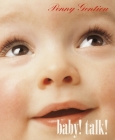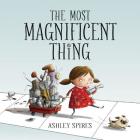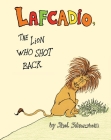Thank you for the sense of perspective! We have so many other good books going on here at home that I'm sure you're right about the princess drek falling away. It's nice to be reminded that it's more often the good stuff that sticks.
I recently heard someone say that a better word for "toddler" would be "pointer," given the amount of pointing that kids do from around 15 months to 2 years, before full-blown language sets in. Will is firmly in the pointer phase. He points at dogs and pigeons and other babies on the street; he points to indicate the food he wants; he points and signs "more" when handing me a book to read to him. And he loves to point at pictures.
Specifically, Will has become a huge fan of pages of books with multiple pictures on them. He points at the items on the page, often the same two or three over and over, and I name them. Very satisfying. Sometimes we try it the other way: "Will, where's the dog?" Less accurate results, but still a lot of fun.
 Our absolute favorite book to do this with is a board book I can't believe I haven't written about before: Penny Gentieu's Baby! Talk! We've had this one since Eleanor was a baby (did you give it to us? Probably.) and it's been a huge hit with all three kids. Most of the pages in the book contain a statement of a single baby concept: "Where are baby's toes?"; "How big is baby? So big!"; "Uh-oh!"; "Peek-a-boo! I see you!"; "Clap hands, baby! Patty-cake!" On the facing page, there are pictures of several babies illustrating the concept in different ways:
Our absolute favorite book to do this with is a board book I can't believe I haven't written about before: Penny Gentieu's Baby! Talk! We've had this one since Eleanor was a baby (did you give it to us? Probably.) and it's been a huge hit with all three kids. Most of the pages in the book contain a statement of a single baby concept: "Where are baby's toes?"; "How big is baby? So big!"; "Uh-oh!"; "Peek-a-boo! I see you!"; "Clap hands, baby! Patty-cake!" On the facing page, there are pictures of several babies illustrating the concept in different ways:Will loves these pages. He reads "Uh-oh!" aloud, and plays peek-a-boo himself. But the page he turns to most often is the first page of the book:
*point* "Dog."
*point* "Spoon."
*point* "Cat."
*point* "Ball."
*point* "That's the dog again."
*point* "Spoon."
This is so consistently fascinating that I've started packing Baby! Talk! in the diaper bag every time we go out.
Luckily, children's book publishers seem to recognize the importance of the point-able illustration design. Every photo spread in Eating the Rainbow offers a similar opportunity:
While The Noisy Book presents only one illustration per page, the inside front and back covers show lots of little square images of the pictures and sounds contained in the book as a whole:
These are pages I used to skip over without thinking when reading the book aloud, but they're Will's favorite place to stop. And point. And point. And laugh. And point again. And keep me reading at his pace.
Love, Annie












